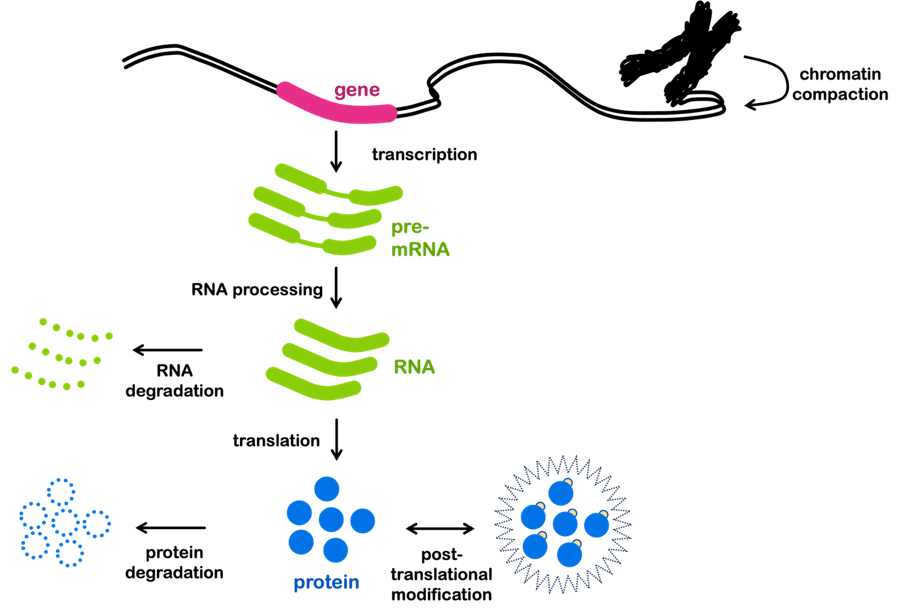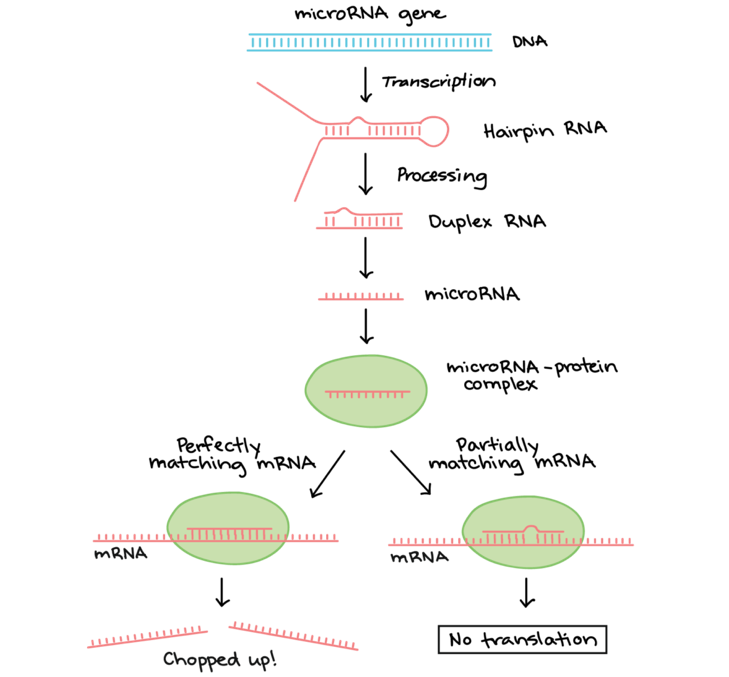Additional levels of gene regulation
You’ll recall from the chapter on Overview of Gene Regulation, we introduced the levels at which genes could be regulated, which is revisited here in Figure 11.

Both this chapter and the chapter on Overview of Gene Regulation have focused on regulation of gene expression at the level of transcription, focusing on the interactions of transcription factors that drive gene expression.
But keep in mind that the gene action also is affected by these other levels of control:
- RNA molecules are degraded after time, with long-lived RNA molecules typically being used to produce more protein than short-lived RNA.
- Translation can be increased or blocked by factors that interact with an RNA molecules.
- Post-translational modifications (either through covalent modification or non-covalent interactions with signaling molecules) can change the structure and behavior of proteins in the cell. This is a common method of regulation in cell-signaling, which allow a cell to respond to a chemical signal from the environment – kind of like the presence of lactose changes the behavior of the lac repressor, as we saw in the chapter on Overview of Gene Regulation.)
- And protein degradation is important in “turning off” the action of a gene as well
mRNA degradation via miRNA
Along those lines, another mechanism of control is the action of small regulatory RNAs.
One class of small regulatory RNA is microRNA (miRNA). miRNAs should not be confused with mRNA (messenger RNA). mRNA is translated into protein, but miRNA are functional RNAs that will never be translated.
Precursors to miRNA molecules are transcribed as longer RNA molecules that typically self-base-pair to fold up and form hairpins (Figure 12). Their respective genes are transcribed by either RNA Pol II or RNA Pol III. The long hairpin is cut into smaller fragments of double-stranded, or duplex, RNA. These fragments are typically only about 20 base pairs long.
One strand of the duplex RNA is typically loaded into a protein complex that mediates the interaction between the miRNA and a complementary mRNA. The interaction between the miRNA and its binding partner mRNA can lead to the dicing up of the mRNA; the degradation blocks the production of protein in the cell. In some cases, imperfect base pairing between the miRNA and mRNA does not trigger the dicing of the mRNA. Instead, the interaction between mi- and mRNA blocks translation of the mRNA. This process, called RNA interference (or RNAi) is illustrated in Figure 12.
Although the most well-studied examples of miRNA gene regulation down-regulate translation from target RNAs, there are also examples of miRNA increasing protein production or regulating transcription. And while most miRNAs appear to regulate mRNAs in the cells in which they are produced, some miRNAs may be exported from the cell to regulate mRNA stability in nearby cells.[1]

Andrew Fire and Craig Mello were awarded the Nobel Prize in Physiology or Medicine in 2006 for their discovery of RNA interference. Their work had a great influence on the tools of genetic manipulation in the lab: cellular mechanisms of RNA interference have been exploited by geneticists to experimentally silence the expression of target genes. These experiments are a form of reverse genetics, since the phenotype of cells or organisms can be monitored following gene silencing.
miRNAs (and related siRNAs) are also being exploited for therapeutic use: a sequence can be readily designed to target any gene product and delivered to target cells. They may be able to act on disease when traditional methods targeting cellular proteins do not. miRNA and siRNA drugs are in development for the treatment of diseases like cancer and hereditary metabolic disorders.
Test Your Understanding
Media Attributions
- Figure 11 GE REgulation Levels of Gene Regulation © Amanda Simons is licensed under a CC BY-SA (Attribution ShareAlike) license
- Figure 12 GE Regulation microRNA © Narayanese adapted by Amanda Simons is licensed under a CC BY-SA (Attribution ShareAlike) license
- O’Brien, J., Hayder, H., Zayed, Y. & Peng, C. Overview of MicroRNA Biogenesis, Mechanisms of Actions, and Circulation. Front. Endocrinol. 9, (2018). ↵

